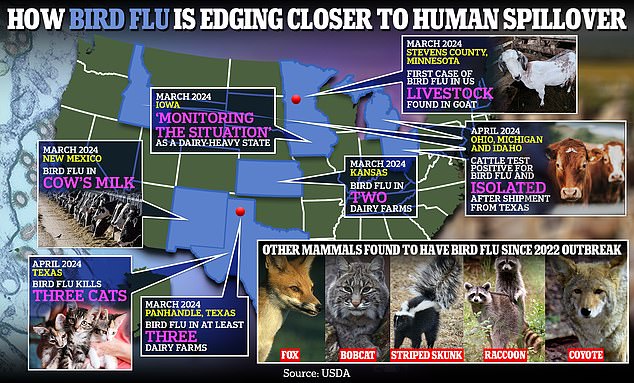‘Be prepared’: CDC convenes meeting on bird flu outbreak, where it directs state health officials to prepare for more human cases
State health officials have been told to prepare for more human cases of bird flu, fearing the virus could jump to humans.
CDC officials issued the alert Friday, urging state leaders to have “current operational plans” ready in case more farmworkers test positive for H5N1.
They stressed that the risk to the public is still low, although farm workers in close contact with infected animals and equipment may be at greater risk.
So far, only one case has been reported in a person in Texas, but officials fear more people in close contact with infected livestock may also have H5N1.
Cattle on 16 farms in seven states – mainly in Texas – have tested positive for the virus, with doctors now being urged to test for the disease any farm worker they suspect may be infected.

The above shows how bird flu in the US is moving closer to human spillover
The meeting was led by CDC Deputy Director Nirav Shah and Dr. Demetre Daskalakis, who was involved in the national response to the 2022 monkeypox – or mpox – outbreak.
The conference was attended by local health leaders, including representatives from the Association of State and Territorial Health Officials, which has members in all 50 states and Washington DC.
A CDC press release about the meeting said: “CDC has recommended that state public health officials…ensure they have current operational plans to respond to avian flu at the state level.
“For example, the CDC emphasized the importance of plans to quickly provide testing and treatment to potentially affected farmworkers following positive results among livestock populations.”
The news release added that officials “emphasized that while the risk to the public remains low, the agency wants state public health officials to be prepared to respond.”
The one person infected with the virus has only one symptom – inflammation of the eye – and is reported to be in isolation and ‘recovering well’.

The map above shows states where infections in cattle have been detected
They are also being treated with the drug oseltamivir, or Tamiflu, and are not believed to have passed the virus on to anyone else.
Texas has reported the most livestock infections, with eight dairy farms testing positive for the virus.
Herds in Kansas, New Mexico, Ohio, Michigan and Idaho have also been found to be infected with the virus.
In the human patient, tests showed that the virus had mutated. However, the CDC said this did not change their risk assessment, saying the mutation had been seen before and that they were not concerned that the virus was getting better at infecting people.
It comes after the CDC said it was taking bird flu “very seriously,” with the agency’s director, Dr. Mandy Cohen, adding that they were “monitoring the situation very closely.”
“Any case of H5N1 is concerning,” she said, “because it is very dangerous to humans, although it has never been shown to be easily transmissible between humans.”
Experts are concerned that H5N1 could spread to humans because it has already infected so many mammal species — at a count of more than 40, from foxes to raccoons, skunks, cats and even polar bears.
Each infection increases the risk of acquiring a mutation that makes the virus more able to infect people, they said.
There are also concerns about the price of milk and eggs.
Officials say there is little risk of the virus being extracted from milk because almost everything is pasteurized, which deactivates viruses and bacteria. The milk of cattle infected with the virus is also removed from the stock.
But there are concerns that if too many cows become infected and too much milk is extracted, it could drive up milk prices.
Last week, the US’s largest egg producer – Cal-Maine Foods in Texas – revealed it had to cull 2 million birds after the virus was discovered in its flock.
The cull of bird flu was behind the rise in egg prices in 2022, when the cost of a dozen large, Grade A eggs rose from $1.72 to $3.59 in the year to November 2022, before being closed in January the following year peaked at $4.82.
